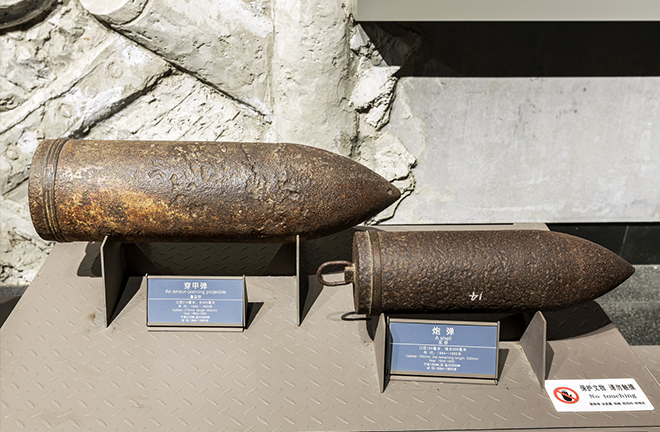Jiawu shipwreck research adds luster to underwater archaeology

An armour-piercing projectile and a shell on display at the Museum of the Sino-Japanese War 1894-1895 on the Liugong Island in Weihai, east China's Shandong Province Photo: TUCHONG
This year marks the 130th anniversary of the First Sino-Japanese War (1894–95), commonly known in China as the Jiawu War, as well as the 10th anniversary of the Jiawu shipwreck underwater archaeological project. At a symposium to commemorate these anniversaries held in east China’s Shandong Province on August 4, scholars reviewed the fruitful results of underwater archaeology efforts at the Jiawu shipwreck sites, saying the project has set a Chinese example for underwater archaeological investigations, research, and protection of shipwreck sites dating to modern times.
The discovery of the Zhiyuan shipwreck site in 2014 marked the beginning of a series of underwater archaeological explorations of ships sunk during the First Sino-Japanese War. Over the past decade, the wrecks of seven ships have been found in the Yellow Sea off the coasts of Liaoning Province and Weihai Bay in Shandong, yielding thousands of precious artifacts. Apart from ship components, weapons, and munitions, the artifacts include sundry daily items used by the crew, such as sailor ID tags, name-engraved telescopes, porcelain bowls, leather shoes, mahjong tiles, chess pieces, buttons, and perfume bottles. These objects reveal the true history of the First Sino-Japanese War, telling stories of the heroic final moments of Chinese naval officers and sailors.
According to Tang Wei, director of the National Center for Archaeology (NCA) under the National Cultural Heritage of China, over the past decade, the Center has collaborated with cultural organizations and museums in Shandong and Liaoning provinces to carry out ongoing underwater archaeology at the Jiawu shipwreck sites. These efforts utilize a comprehensive approach that combines historical document analysis with advanced underwater archaeological and marine geophysical prospecting technologies.
Moreover, archaeologists have explored, summarized, and verified the theoretical, methodological, and technical systems concerning underwater archaeology of modern large steel shipwrecks, drawing extensive attention among domestic and global archaeological communities and the public, Tang said.
The decade-long underwater archaeological project into the Jiawu shipwrecks has pinpointed the exact location and identified the preservation status of all located ships, revealing sites that had been concealed on the ocean floor for 130 years, said Zhou Chunshui, a research librarian at the NCA. Additionally, a great number of valuable artifacts have been unveiled, alongside substantial details regarding the warships and the Beiyang Fleet, one of four modernized regional navies established by the Qing Dynasty (1644–1911) in 1871. These relics offer new insights into naval battles fought during the First Sino-Japanese War.
Zhou added that Chinese underwater archaeologists have developed an underwater archaeology system with distinct Chinese characteristics. Based on the large size, high tonnage, and complex structures of the Jiawu shipwreck sites, archaeologists have creatively integrated the latest multidisciplinary research on underwater detection and heritage conservation into every phase of shipwreck archaeology. As a result, they have crafted a set of new methodologies for studying large shipwrecks from modern times, including magnetic surveying, sand pumping positioning, panoramic site demonstration, on-site relic protection, and in-situ preservation.
The symposium was jointly held by the NCA, the Shandong Underwater Archaeology Research Center, the Shandong Museum, and the national revolutionary relics collaborative research center under the auspices of the Museum of the Sino-Japanese War 1894–1895 and Shandong University. On the sidelines of the symposium, an exhibition titled “Bear in Mind the History—The Exhibition of Sino-Japanese Naval War and Underwater Archaeological Finds from the Warship Wrecks” commenced at the Shandong Museum, displaying more than 330 artifacts unearthed from the warships.
Edited by CHEN MIRONG

 PRINT
PRINT CLOSE
CLOSE